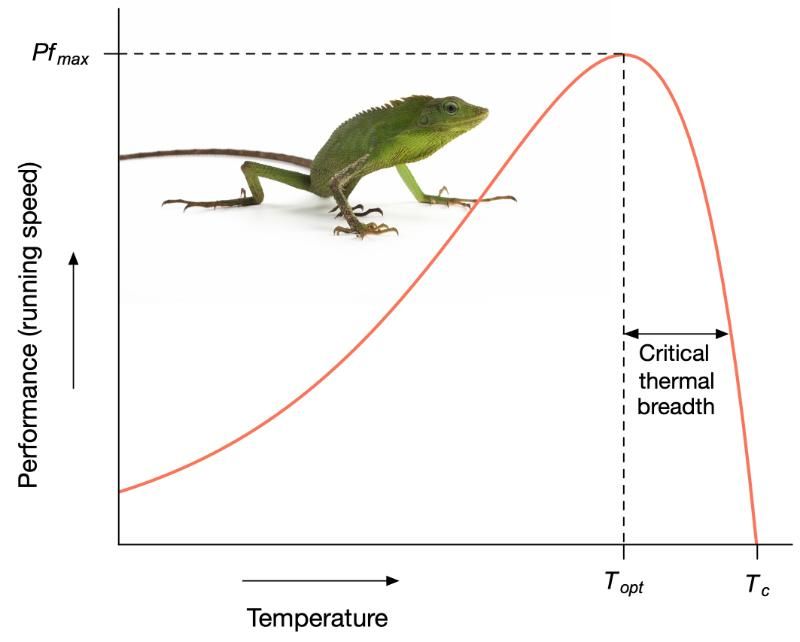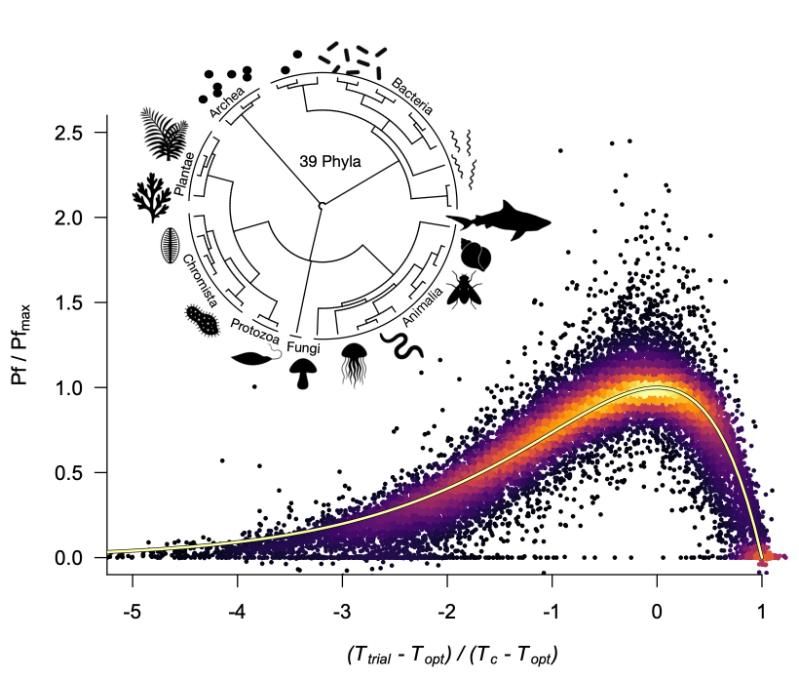What goes up must come down – scientists unearth “universal thermal performance curve” that shackles evolution
Posted on: 21 October 2025
This “UTPC" seemingly applies to all species and dictates their responses to temperature change. It essentially “shackles evolution” as no species seem to have broken free from the constraints it imposes on how temperature affects performance.
All living things are affected by temperature, but the newly discovered UTPC unifies tens of thousands of seemingly different curves that explain how well “species work” at different temperatures.
And not only does the UTPC seem to apply to all species, but also to all measures of their performance with regard to temperature variation – whether you are measuring lizards running on a treadmill, sharks swimming in the ocean, or recording cell division rates in bacteria.
Crucially, the new UTPC shows that as all organisms warm:
- performance slowly increases until they reach an optimum (where performance is greatest),
- but then with further warming performance quickly declines.
- The rapid decline above optimum temperatures means overheating can be dangerous, risking physiological failure or even death.

A hypothetical generalised thermal performance curve (TPC), illustrating how performance traits —such as running speed in lizards —exponentially increase with temperature until reaching a maximum performance at the optimal temperature. Beyond this peak, performance declines sharply as temperature continues to rise, eventually reaching a minimum or collapsing at the critical temperature. Image: Prof. Nicholas Payne and Prof. Andrew Jackson, Trinity College Dublin.
One obvious takeaway from the work, just published in leading international journal PNAS, is that species may be more constrained than feared when it comes to their ability to adapt to global climate change, given that in most places temperatures are accelerating.
Andrew Jackson, Professor in Zoology in Trinity’s School of Natural Sciences, and co-author, said: “Across thousands of species and almost all groups of life including bacteria, plants, reptiles, fish and insects, the shape of the curve that describes how performance changes with temperature is very similar. However, different species have very different optimal temperatures, ranging from 5oC to 100oC, and their performance can vary a lot depending on the measure of performance being observed and the species in question.”
“That has led to countless variations on models being proposed to explain these differences. What we have shown here is that all the different curves are in fact the same exact curve, just stretched and shifted over different temperatures. And what’s more, we have shown that the optimal temperature and the critical maximum temperature at which death occurs are inextricably linked.”
“Whatever the species, it simply must have a smaller temperature range at which life is viable once temperatures shift above the optimum.”
 Biological performance across the tree of life collapses onto the Universal Thermal Performance Curve (UTPC). Shown are approx. 30,000 performance measurements derived from seven kingdoms, 39 phyla and 2,710 experiments. Performance is represented by diverse rates including metabolism, individual growth, foraging intensity, voluntary activity, and population growth. Data are presented on both axes relative to the parameters (Topt , Tc and P fmax ) estimated by fitting the UTPC equation to each of the 2,710 experiments; the UTPC is overlaid as a yellow line. Data are coloured by the relative density of neighbouring points.Image credit: Prof. Nicholas Payne and Prof. Andrew Jackson, Trinity College Dublin.
Biological performance across the tree of life collapses onto the Universal Thermal Performance Curve (UTPC). Shown are approx. 30,000 performance measurements derived from seven kingdoms, 39 phyla and 2,710 experiments. Performance is represented by diverse rates including metabolism, individual growth, foraging intensity, voluntary activity, and population growth. Data are presented on both axes relative to the parameters (Topt , Tc and P fmax ) estimated by fitting the UTPC equation to each of the 2,710 experiments; the UTPC is overlaid as a yellow line. Data are coloured by the relative density of neighbouring points.Image credit: Prof. Nicholas Payne and Prof. Andrew Jackson, Trinity College Dublin.
Senior author, Dr Nicholas Payne, from Trinity’s School of Natural Sciences, added: “These results have sprung forward from an in-depth analysis of over 2,500 different thermal performance curves, which comprise a tremendous variety of different performance measures for a similarly tremendous variety of different species – from bacteria to plants, and from lizards to insects.”
“This means the pattern holds for species in all major groups that have diverged massively as the tree of life has grown throughout billions of years of evolution. Despite this rich diversity of life, our study shows basically all life forms remain remarkably constrained by this ‘rule’ on how temperature influences their ability to function. The best evolution has managed is to move this curve around – life hasn’t found a way to deviate from this one very specific thermal performance shape.”
“The next step is to use this model as something of a benchmark to see if there are any species or systems we can find that may, subtly, break away from this pattern. If we find any, we will be excited to ask why and how they do it – especially given forecasts of how our climate is likely to keep warming in the next decades.”
This work was supported by Research Ireland and a Marie Sklodowska-Curie Postdoctoral Fellow grant.
Media Contact:
Thomas Deane | Media Relations | deaneth@tcd.ie | +353 1 896 4685
